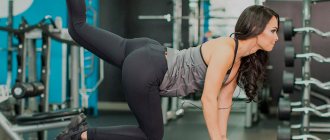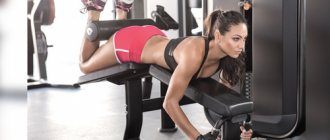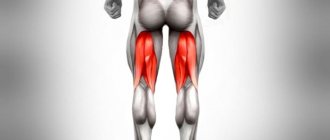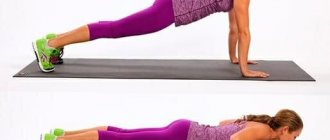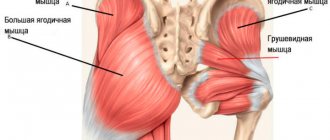The leg muscles are one of the largest muscle groups, as well as the most important in bodybuilding. The importance of training for this muscle group is greatly underestimated not only by beginners, but also by experienced athletes. Underestimation consists of insufficient loads, or complete disregard for training for a given muscle group.
What is the importance of systematic training of leg muscles?
- First of all, it will be important to say that leg exercises are the most energy-intensive, as well as the most resource-intensive in terms of recovery after hard training. This factor seriously helps in fat burning.
- Such a basic exercise as “barbell squats” allows you to increase the production of endogenous (own) testosterone, which directly contributes to a faster gain of overall muscle mass. Therefore, when squatting with a barbell, you simultaneously pump your back, shoulders, and biceps.
- Exercise increases blood circulation in the pelvic area, which speeds up metabolism and also has a beneficial effect on sexual health.
- The symmetry of the upper and lower parts of the body is maintained, which will give your figure additional points from the assessment of others.
How to train legs in the gym? The possible exercises are, of course, limited by the equipment available in gyms. Therefore, we will describe the exercises known to us, from which it will be possible to create a training program based on the available equipment:
Barbell Squat (Basic Exercise)
The barbell squat is the most basic and effective leg exercise. This exercise stimulates the body's production of its own testosterone, which has a beneficial effect on overall muscle growth. The exercise is aimed at developing the thigh muscles of the legs.
How to do the exercise correctly?
- You need to perform squats with a barbell in a special rack, which will help you comfortably remove and put back the training equipment. The corresponding rack also provides insurance in case you pick up too much weight, incommensurate with your capabilities, and the bar pulls you down. (Example in the picture below)
- Having prepared a barbell with the required weight on a special rack, you can begin performing the exercise. It is necessary to correctly place the projectile on the shoulders for a comfortable and less traumatic execution. To do this, place the bar on the lower part of the trapezius muscle so that it runs along the back of the shoulders. (An example of the correct position of the barbell is in the figure below)
- After correctly placing the sports equipment on your shoulders, you remove it from the rack by taking a couple of steps back and placing your feet shoulder-width apart, with your toes slightly turned up - 20-30 degrees outward. After which, taking a deep breath, gradually (not quickly), controlling the barbell, you begin to lower yourself into a squat. Having brought your thigh muscles in a squat to parallel with the plane of the floor surface, as you exhale, you begin to rise up until your legs are completely straightened. To avoid injury during the exercise, your back must be kept straight at all times, without bending inward or leaning forward. Always look straight ahead or slightly up. After completing the exercise, you place the apparatus back on the rack. (Example in the picture below)
The exercise consists of several warm-up approaches and 3 working sets. A normal working set consists of 6-8 repetitions. Performed with the maximum weight for you with which you can do the specified number of repetitions.
This is one of the most difficult and traumatic exercises, so it is necessary to take all possible precautions:
- Before performing working approaches to the exercise, a good warm-up is necessary , namely 3-4 warm-up approaches.
The first warm-up approach should be regular squats without a projectile with your own hands on your shoulders (Your back should be straight. You should perform 15-20 squats at an average pace in order to thoroughly stretch the tendons and joints, as well as warm up the muscles). The next warm-up exercise is already performed with a projectile on the shoulders with a light weight. It is enough to do 2-3 such approaches, slightly increasing the weight, approaching the maximum working level. Due to this, you will gradually prepare your joints, tendons and muscles for maximum stress. - Use a special belt, fixing the back muscles. It will help you avoid back injuries when performing exercises with heavy weights.
- Feel free to ask for insurance in the hall (from friends who visit the gym with you or from others who train in this gym). The belay will help you complete the exercise to the maximum (when you are already “sagging” on the last repetitions of the working set, the belays will be able to help you a little to pull the barbell up).
An additional guide to mastering the correct method of performing the exercise will be the video below:
Leg exercises. Squats.
To summarize, there is a huge amount of audio/video/text material on the Internet about the correct exercise technique. All of these materials may differ slightly from what is described in this article. But these differences are minor details that do not in any way affect the result of the exercise. If you do the main things in the exercise correctly: keep your back, bring your hips to parallel, use a belt, control the barbell , then everything is fine. And if after training your thigh muscles hurt, then you are undoubtedly on the right track.
Pain is the main indicator that you are loading the target muscle correctly.
Leg press (Basic exercise)
The leg press is also a very serious exercise in leg training.
The authors of the resource classified it as basic due to its similar properties compared to the classic squat with a barbell. Naturally, if possible, it is advisable to give preference to the squat, but there are different situations (for example, injuries) that force you to consider replacing the squat with the leg press. In any case, we consider the leg press to be a very good exercise that has a targeted effect on the development of the thigh muscles. Correct execution of the exercise:
- The leg press is performed in a specialized leg press machine. On the simulator, you need to adjust the angle of the back of the simulator chair, as well as the angle of the stand for resting your feet. Then set the required load weight and begin execution.
- After the necessary adjustment of the simulator and the load weight, it is necessary to take a position in the chair in such a way that the pelvis fits tightly to the back, and the buttock muscles fit tightly to the seat of the chair. The legs should be placed 15-20 degrees outward from parallel. We place the toes of the feet identically. Now remove the clamps and keep the weight on your outstretched legs.
- The mechanics of the exercise involve lowering and lifting weights. The legs must be bent until a right angle (90 degrees) is formed between the calf muscle and the back of the thigh. The lower position (when the legs are bent) is well illustrated by the image above.
- When performing the exercise, the emphasis should be on correct technique and constant weight control. It is also necessary to control the position of the pelvis and gluteal muscles in relation to the back and seat of the chair.
The exercise consists of 2-3 warm-up approaches and 3 working approaches. Warm-up approaches are done with light weights in the simulator. The working weight gradually approaches the weight in the working approach, preparing the muscles and joints for maximum loads. Number of repetitions in warm-up and working approaches: 8-10.
For a visual representation of how to perform the exercise correctly, watch the video below:
Leg exercises. Leg press.
Everything you need to know about butt and leg exercisers
- Exercise machine for leg extension and reduction.
Leg raises are not a basic exercise, but an auxiliary exercise aimed at developing the gluteus medius and minimus muscles. This exercise cannot increase volume, as other strength machines for the buttocks that are available in any gym can help you do. But sometimes an exercise should be included in your program in order to work the muscles from a different angle and give them a load that they are not used to. - Leg tuck is an auxiliary exercise for working the inner thighs. The adductor muscles receive a load that they do not experience in real life or in basic exercises.
- Bench (Roman chair) for hyperextension.
If in hyperextension on the gluteal muscles (lifting the body with fixed legs) you keep the spine straight and arched in the lower back, then the load will be evenly distributed across three muscle groups: the hamstrings, gluteal muscles and back extensors. If you round your back and straighten your lower back, the load will move from your back to your buttocks and hips, which is ideal for women. This bench is inexpensive and is often used as a home exercise machine for the abs, buttocks and legs. The exercise is not mandatory, but is perfect for beginners and is widely used in rehabilitation cases. - Reverse hyperextension (straight leg raises while lying on a bench) will not enlarge the buttocks. The exercise will highlight them and give them a beautiful shape, provided that there is already muscle volume.
- Leg press machine.
The 45-degree platform press turns off the front of the thigh and maximally engages the muscles that lift the buttocks: the posterior adductor, semimembranosus, and semitendinosus muscles. The buttocks receive maximum stress only in a shortened amplitude. It is advisable to choose a machine with a large platform and place your feet as wide as possible. Men mainly perform the exercise with two legs, women - with each leg in turn. - By resting your toes on the platform, you can pump up your lower leg muscles. The exercise is especially relevant for women, since by increasing the inner or outer part of the lower leg, crooked legs can be corrected.
- Smith machine.
- When squats in a professional strength training machine, the load on the stabilizer muscles is reduced, the back practically remains straight, the spine does not suffer, the load is removed from the quadriceps and the buttocks and back of the thigh receive the maximum load. The emphasis can be shifted by changing the length of the step.
- Reverse lunges in the Smith machine are done by placing one leg back. The exercise will help girls diversify their workouts and quickly achieve such perfect shapes as in the photo of bikinists.
- You can do lunges by placing one supporting leg on an elevated platform. You must always hold onto the barbell with your hands, having previously fixed it at a height convenient for your height. Hands only help maintain the trajectory of movement. If the walking platform is low, then for a deep squat you will have to bend your free leg at the knee. The exercise works the area under the buttocks, reducing the problem area and lifting the buttocks upward.
- In the Smith machine you can also do the notorious deadlift on straight legs. The legs are brought forward, so when the pelvis is pulled back, the maximum stretch of the femoral biceps occurs.
. From the name it’s easy to guess that the trainer was created by the famous Russian bodybuilder Georgy Gakkenshmidt. Hack squats engage the quadriceps and lateral thighs and significantly reduce the load on the knees and stabilizer muscles. However, they do not replace barbell squats, as they load the superficial muscle layers. These squats are suitable for those who have not previously squatted with a barbell or have lower back problems.
Hackenschmidt simulator- Standing leg curl machine . Leg bending in a standing simulator is performed with each leg alternately with a straight back and without bending forward. The outer part of the biceps femoris, the biceps femoris, sways. Exercise has little effect on muscle volume, but improves their quality.
- Lying leg curl machine . Lying leg curls in a free weight machine are not much different from bending in a similar block weight machine. A free weight machine allows you to train each leg at a time and improve underdeveloped lower hamstrings. In the weight-block design, the middle part of the thigh works more. The roller is always adjustable according to height, and the knees fall below the center of rotation of the machine - they hang from the bench. The backrest is adjusted experimentally: if it is too low, it loads the front surface of the thigh; if it is too high, it causes the lower back to bend dangerously.
- Seated calf raise machine . Focusing on the big toes will add volume to the lower leg, make it more muscular - it will shape and help develop the outer parts of the calf muscles and soleus muscles. The exercise is rarely done by women.
. By spreading your legs wide and turning your knees and toes slightly to the sides, you can perfectly pump the inner surface of the thigh without swaying the outer surface (especially important if you have “ears”). In a narrow leg position, only the quadriceps develop. If the exercise is easy, it is better to replace it with another, but under no circumstances perform the movement quickly or jerkily.
Leg extension machine- Leg abduction machine . In a power simulator, legs with a load are pulled back one by one. The design minimizes stress on the kneecaps and thigh muscles. The load goes to the muscles of the buttocks and biceps of the thigh.
- Crossover . By abducting the legs in a crossover, you can work the outer, back, inner thighs and gluteal muscles. The leg should be abducted without turning the body and slightly straightened at the knee.
- Gravitron . Can be used to strengthen the gluteal muscles by doing the platform press down with each leg alternately.
Hack machine squats
Squats in a hack machine are also a very good exercise for the thigh muscles of the legs. The only drawback (of course, this is for provincial towns) is that this machine cannot be found in every gym. It is unlikely that it will be possible to call the hack squat a full-fledged replacement for a squat with a barbell, however, this exercise is good to include in the training process in bodybuilding due to the fact that it allows you to well isolate auxiliary muscle groups and create a load directly on the target muscles. The difference between this exercise and others aimed at developing the thigh muscles is that it removes the load from the back muscles, but the exercise puts a slightly greater load on the knee ligaments.
Correct execution of the exercise:
- Before starting the exercise, you must install the necessary weights on the machine. Then sit down in the machine itself, pressing your back tightly against the back of the machine. The feet must be placed shoulder-width apart at some distance from the plane of body movement - approximately the length of the femur.
- The exercise consists of a progressive movement down and up. At the top point, you fully straighten your legs. At the bottom, create a 90-degree angle between the calf and femoral muscles.
The exercise consists of 2 warm-up approaches and 3 working approaches. Warm-up approaches are done with light weights in the simulator. The working weight gradually approaches the weight in the working approach, preparing the muscles and joints for maximum loads. Number of repetitions in warm-up and working approaches: 8-10.
For a visual representation of how to perform the exercise correctly, watch the video below:
Leg exercises. Hack squats.
Cardio and bodyweight equipment
- Treadmill.
Running on a treadmill is less effective than jogging outside. The problem is the lack of forward movement of the body, because the surface moves under the feet. The load on the buttocks and hamstrings is reduced, and the quadriceps femoris muscle becomes overactive. This can lead to muscle imbalance. - The treadmill allows you to do lunges while walking, which is impossible to do in small gyms. You just need to pick up the dumbbells and select a low speed.
- Exercise bike. Riding an exercise bike strengthens the muscles of the legs and buttocks, improves mobility and flexibility. The muscles of the arms and back receive significant static load.
- Elliptical trainer (orbitrek). The ellipsoid is perfect for those who suffer from varicose veins and joint problems. Involves the muscles of the back of the thighs, lower legs, and buttocks. The muscles of the arms, abs, and shoulder girdle are partially worked. By doing the reverse stroke, you can work the glutes, hamstrings, and leg muscles that cannot be used on the exercise bike or treadmill.
- Step trainer (climber). An attractive and simple-looking stair stepper is not suitable for beginners - training requires remarkable physical fitness and endurance. With its help, almost all muscle groups of the lower belt and the respiratory system are trained.
- Stepper . The exercise machine simulates walking on steps, reducing the load on the knee joints. Trains the buttocks, leg muscles, partly the abdominal and back muscles. You can adjust the load for each pedal separately. Used by beginners, for joint problems, and during the rehabilitation period after knee injuries.
Leg bending in the simulator
The leg curl is an isolation exercise aimed at developing the hamstrings (hamstrings).
It is a good exercise to add to your leg training program, because... in most gyms is the single most comfortable and targeted exercise for the hamstrings. Correct execution of the exercise:
- Before starting the exercise, you need to set the load weight you need on the simulator and adjust the support to a comfortable length. The support should rest against the Achilles tendon of the leg, and the kneecaps should be lower than the support on which the thigh muscles are located to avoid pain.
- After positioning in the simulator, it is necessary to make flexion movements, directing the heels to the gluteal muscles and back. It is necessary to control the weight especially at the lower point of support, when you fully extend your legs, in order to avoid painful sensations in the knee joints.
The exercise consists of 2 warm-up approaches and 3 working approaches. Warm-up approaches are done with light weights in the simulator. The working weight gradually approaches the weight in the working approach, preparing the muscles and joints for maximum loads. Number of repetitions in warm-up and working approaches: 8-12.
For a visual representation of how to perform the exercise correctly, watch the video below:
Leg bending in a lying simulator: technique and nuances
Leg extension in the simulator
The machine leg extension is an isolation exercise for developing the quadriceps muscle.
A good exercise for finally finishing off the front of the thigh after heavy basic exercises. Correct execution of the exercise:
- Before starting the exercise, you need to set the load weight you need on the simulator and adjust the support to a comfortable length. The support should rest against the ankle. You can adjust the position in the exercise chair to your liking.
- The mechanics of performing the exercise consist of extension/bending of the legs. An iteration of the cycle consists of raising the support, fixing it, lowering the support.
The exercise consists of one warm-up approach and 3 working sets. The load in the warm-up approach is 60-70% of the weight of the working approach. Number of repetitions in warm-up and working approaches: 8-12.
For a visual representation of how to perform the exercise correctly, watch the video below:
Leg extension in the simulator
Leg muscle training program
Workout 1
| Exercise | Approaches | Repetitions |
| 1. squats | 5 | 6-10 |
| 2. lunges with dumbbells | 5 | 10 per leg |
Workout 2
| Exercise | Approaches | Repetitions |
| 1. hack squats | 4 | 10-12 |
| 2. leg press | 4 | 10-12 |
| 3. deadlift on straight legs | 3 | 10-12 |
Workout 3
| Exercise | Approaches | Repetitions |
| 1. squats | 3 | 6-12 |
| 2. deadlift on straight legs | 3 | 10-12 |
| 3. leg extension | 3 | 12-20 |
| 4. leg curl | 3 | 12-20 |
Calf muscle training
Training the calf muscles is not that complicated. It involves lifting/lowering the weight using the lower leg muscles. In gyms there are not many variations of machines for such loads and they are all identical in terms of execution mechanics. It’s easy to understand training equipment as well as the mechanics of execution. (examples of exercise equipment for training the calf muscles are illustrated below)
The exercise consists of one warm-up approach and 3 working sets. The load in the warm-up approach is 60-70% of the weight of the working approach. Number of repetitions in warm-up and working approaches: 8-12.
The described set of exercises is enough to create the necessary program for training the muscle groups of the legs. There are, of course, a lot of additional exercises that can be considered as an alternative to non-basic ones. However, we do not recommend filling your head with a lot of exercises, so that the whole thing does not become a mess (especially for beginners).
Author: Full-Fit
Training Recommendations
Unlike the pectoral muscles and back corset, our legs work almost constantly, and therefore require a special approach to training for growth.
- Remember, your legs are used to high reps, so you need to perform low reps with maximum weight.
- Watch the position of your socks. If necessary, use wooden planks to accentuate the load. Depending on the position of the heels and toes, the load in the same basic exercise can differ radically.
- Remember the rule: first the basic ones, then the isolating ones.
- Legs should not be heavily trained more than once a week.
- Pay attention to your calves right away. Since they participate in all the basic exercises, they need extra stimulation from the very beginning, otherwise they will not grow at all.
- Don't forget about traction. By eliminating deadlifts on leg day, many athletes experience serious hamstring lag.


